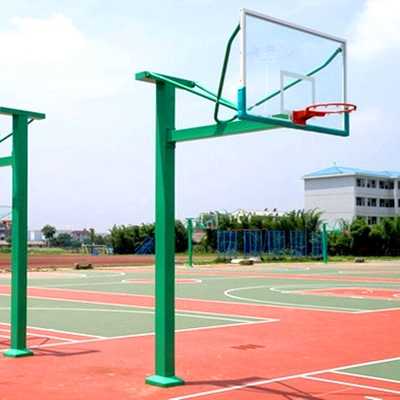How to maintain fixed basketball hoops in a stadium?
The maintenance of fixed basketball hoops in stadiums requires a combination of daily inspections, regular maintenance, and specialized repairs to ensure structural safety, proper function, and extended lifespan. The following are specific maintenance steps and key points:

I. Daily Inspection (Weekly/Before Each Use)
Structural Stability Check
* **Post to Ground Connection:** Check for loose embedded parts and signs of cracking or settlement in the concrete at the base of the post.
* **Arm to Backboard Connection:** Confirm bolts are tight and secure; ensure the gap between the backboard and arm is uniform (≤1mm).
* **Hoop Fixing:** Check for loose screws connecting the rim and arm, and ensure the spring system (if applicable) is functioning correctly.
Backboard Condition Check
* **Tempered Glass Backboard:** Observe the surface for cracks, scratches, or edge delamination; tap lightly with your finger to hear a clear, crisp sound (no dull thud).
* **PC Board Backboard:** Check for yellowing, deformation, or surface scratches; decreased light transmittance may affect the user experience.
**Ground and Surrounding Environment:** Clear debris around the basketball hoop to avoid collisions or tripping hazards; check the ground for flatness, free of standing water or potholes.
II. Regular Maintenance (Monthly/Quarterly)
Cleaning and Rust Prevention
**Uprights and Extending Arms:** Wipe away dust with a soft cloth, avoiding the use of corrosive cleaners; spray rust-preventive oil (e.g., WD-40) on metal parts, paying particular attention to welded joints and screw holes.
Backboard Cleaning: Wipe tempered glass with glass cleaner, and PC board with a neutral cleaner; avoid scratching with hard objects.
Hot Rim Cleaning: Remove accumulated dust from inside the rim, and check springs (if any) for rust or jamming.
Bolt Tightening and Lubrication
Check all connecting bolts (including backboard, extending arm, and rim) for looseness, and retighten them with a torque wrench to the standard value (e.g., 35 N·m).
Apply grease to moving parts (e.g., rim springs, extending arm adjustment mechanism) to reduce wear.
Verticality and Height Calibration
Use a level or laser rangefinder to check the verticality of the uprights; the deviation should be ≤0.3°.
Measure the rim height (standard 3.05 meters); if the error exceeds ±5mm, adjust the extending arm or embedded parts. III. Specialized Maintenance (As Needed/Annual)
Backboard Replacement
Tempered Glass: Replace immediately if cracks appear or edge delamination exceeds 10cm; replacement must be performed by a professional team to ensure a tight seal.
PC Board: Replace if yellowed, deformed, or if light transmittance is below 70%; select a board matching the original model.
Embedded Part Repair
If embedded parts are loose or concrete is cracked, re-pour is required: excavate the surrounding ground to the bottom of the embedded part, clean the rust, insert new reinforcing steel, and pour high-strength concrete (C30 or higher).
Structural Reinforcement
For basketball hoops older than 5 years, check if the column wall thickness has decreased (due to corrosion); if the wall thickness is less than 70% of the original design value, weld thicker steel plates or replace the columns.
IV. Seasonal Maintenance
Rainy Season/Hydraulic Environment
Check the drainage system for blockages to prevent water accumulation and corrosion of embedded parts; increase the frequency of anti-rust coating on metal parts. Winter/Low-Temperature Areas: In cold regions, wrap the edges of the backboard with insulation material to prevent tempered glass from shattering due to excessive temperature differences; avoid prolonged exposure to low temperatures to prevent the PC board from becoming brittle.
Typhoon/Strong-Wind Areas: Before a typhoon, check the basketball hoop's stability; temporarily reinforce it with sandbags or ground anchors if necessary.
V. Maintenance Records and File Management: Establish a maintenance log. Record the time, content, replaced parts, and responsible person for each inspection, maintenance, and repair.
Arrange photos or videos for future problem tracking.
Supplier Collaboration: Retain the basketball hoop manufacturer's contact information to obtain original parts and technical support; regularly invite a professional team to conduct comprehensive inspections.
VI. Safety Warnings and Usage Guidelines: Do not overload the hoop. Avoid multiple people hanging on the hoop simultaneously or violently dunking; do not hang clothes or heavy objects on the basketball hoop.
Warning Signs: Designate a safety zone within 1 meter of the basketball hoop and post signs such as "No Climbing" and "Caution: Collision."
Child Supervision: Children must be accompanied by an adult when using the basketball hoop; prevent them from climbing the posts or stretching their arms.
padel court,Gymnastic mats, basketball racks, volleyball posts, tennis dwellings, badminton posts, adult gymnastic equipment, parallel bars, horizontal bars, uneven bars, gymnastic rings, balance beams, saddles, hydraulic referee tables, table tennis tables, outdoor fitness equipment, garden fitness equipment
Website:
http://www.hransports.com/faq/326.htmlNEXT:no more
